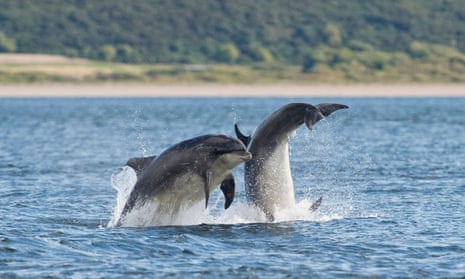The notion of a new tribe of dolphins being identified off the English coast is enough to make anyone’s heart leap. For a long time we’ve known their Celtic cousins – the bottlenose dolphins of Cardigan Bay in Wales, or the same leaping species of Spey Bay near Inverness (where I’m convinced they’ve grown so huge – up to a whale-like 12 feet long – by sitting at the mouth of the salmon-rich river with their mouths open and just letting the fish swim in).
But the amazing work done by the Cornwall Wildlife Trust in identifying 28 individual animals off St Ives – with occasional forays to Devon and Dorset – underlines that human observation and conservation really can affect cetaceans’ lives for the better. Anecdotal reports of increased numbers of humpback whales off the southern and western coasts of Ireland are matched by an upward global trend for this species, which seems to be a clear vindication of the internationally observed decision to stop the hunting of great whales in 1983. Only now is that brave move coming to fruition. I witnessed that personally in March this year, off Sri Lanka, when, together with my dive partner Andrew Sutton, I found myself swimming in a pod of 150 sperm whales – many of them in the act of mating.
This is not the whole picture – there are many anthropogenic effects inflicted on the world’s oceans that endanger whales: noise and plastic pollution, overfishing, acidifying seas add up to an uncertain future, to say the least. Scientists now fear that species such as the North Atlantic right whales, with which I am very familiar from the waters off Cape Cod, may go the way of the eastern Atlantic population off our English shore, and go extinct by the middle of this century.
But if we are to live with this world, we need a sense of hope. Even more important than the statistics is the sense of human encouragement implicit in these reports. Now, more than ever before, we need to be reminded that we can do good; that the effort is worthwhile, in the face of an inevitably pessimistic picture. The endomorphin kick that this communion with another, sentinent, social, and accultured creature gives us is vital reassertion of the optimism we need.
Indeed, it is reflected in our own culture. When she was a young girl holidaying in St Ives, Virginia Woolf saw what she called “porpoises” playing offshore. That vision – of a distant fin, passing far out at sea – came to obsess her, symbolising, for her, the elusive draw of her creative power. She would acknowledge the experience of its secret lure as the impetus behind two magnificent works of modernism, To the Lighthouse and The Waves. She even associated the cetaceans, sensuously, with her lover Vita Sackville-West, in a wondrous, anthropomorphic appropriation.
Now we have Blue Planet II to commodify and mediate that watery allure – the conduit of ecstasy despite the counsel of despair. Through the work of Sir David Attenborough and his colleagues, we are far more accustomed to seeing the sea as animated by these animals. They exhibit our shared mammalian kinship by leaping out of the water. In that moment of miraculous witness, they reconnect us to our atavistic environment – the elemental powerhouse that drives our life on this planet. They become the visible emblem of an alien ocean in which 90% of Earth’s biomass resides. I sometimes wonder if one of the reasons we are so drawn to dolphins is because we share a similar scale – as if they are like us, only in a dolphin wet suit: streamlined, carefree versions of the creatures we’d like to be, if only we could be set free.
But of course, dolphins, like robins, are not deserving of such dreamy idolisation. They may look cute and smiley, but they murder, take drugs, and have promiscuous sex – even with other species. Yet surely that’s the point? The more we learn about these animals, the more we recognise ourselves, and our failings, in them. And in turn, we are reminded that as human as they sometimes appear, we humans are animals, too. There is a glory in that, and we should embrace it.

